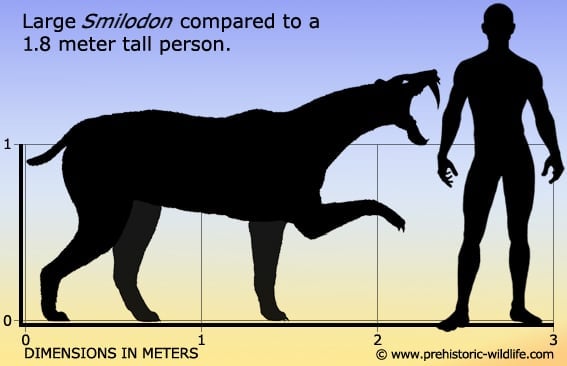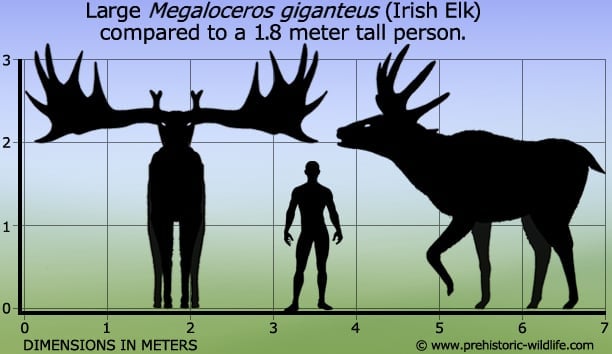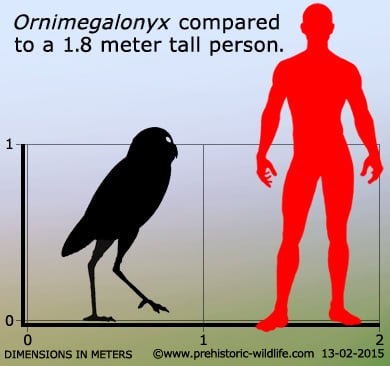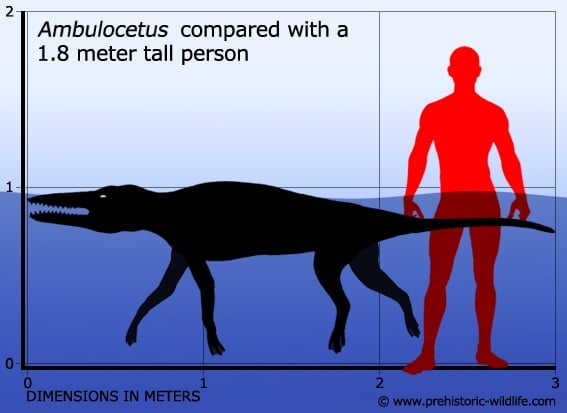|
|
Post by Talira Greycrest on Jun 5, 2021 8:07:51 GMT
Here is where you'll meet animals that lived between 65 million years ago and the present day. We'll be starting with what's probably the most famous prehistoric feline, an animal commonly called the Sabre-toothed tiger: Name: Smilodon Pronunciation: Smile-oh-donMeaning of name: "Knife tooth". Species: S. populator, S. fatalis, S. gracilis.Size: Depending on species, measured up to 2.5 metres long and standing between 1 and 1.5 metres tall. The largest species, S. populator, weighed between 200 and 400kgs.Family: Machairodontinae (a sub-family of Felidae)Diet: Carnivore.First fossils found: Known from hundreds of individuals, many of which were discovered in natural traps such as the La Brea Tar Pits in Los Angeles. First discovered by Danish naturalist, Peter Wilhelm Lund, in caves in Brazil sometime during the 1830s. First discovered in the USA during the second half of the 19th century. S. populator named by Mr. Lund in 1842. S. fatalis named by American palaeontologist, Joseph Mellick Leidy, in 1869. S. gracilis named by American palaeontologist, Edward Drinker Cope, in 1880. Despite commonly being referred to as the Sabre-toothed tiger, Smilodon actually belongs to a different cat family.Lived: 2.5 million years ago to 10,000 years ago from the Gelasian stage of the Pleistocene era through to the Greenlandian stage of the Holocene era in what is now western Canada, South America and the USA. |
|
|
|
Post by Joey12 on Jun 5, 2021 9:40:46 GMT
Oh that's huge.
|
|
|
|
Post by "ROCK" the flamin'cowboy on Jun 5, 2021 10:10:48 GMT
Too big to be a tabby.
|
|
|
|
Post by Talira Greycrest on Jun 5, 2021 10:49:01 GMT
Smilodon is famous for its massive canine teeth. In the largest species, S. populator, the canines measured up to 28cm (11 inches) long.
|
|
|
|
Post by Talira Greycrest on Jun 5, 2021 12:30:39 GMT
This animal is commonly referred to as the Great Irish Elk: Name: Megaloceros Pronunciation: Meg-ah-loss-seh-rossMeaning of name: "Great horn". Species: M. stavropolensis, M. giganteus, M. luochuanensis, M. matritensis, M. novocarthaginiensis, M. savini, M. antecedens.Size: The largest species, M. giganteus, measured around 3 metres long, between 2 and 3 metres tall and weighing up to 700kgs.Family: CervidaeDiet: Herbivore.First fossils found: Known from multiple specimens discovered in Russia, China, Spain, Germany, Ireland and France. M. giganteus named by Johann Friedrich Blumenbach in 1799. The most spectacular feature of this animal was its massive set of antlers. It's believed that only males had antlers and, on some of the larger species, these antlers spanned a width of nearly four metres and weighed more than 30kgs.Lived: 2.588 million years ago from the Gelasian stage of the Pleistocene era through to the most recent Ice Age in what is now Europe and Asia.
 |
|
|
|
Post by Talira Greycrest on Jun 6, 2021 1:08:44 GMT
Sometimes I wonder how this animal was able to lift its head off the ground with those massive and heavy antlers.
|
|
|
|
Post by Joey12 on Jun 6, 2021 2:15:59 GMT
Antlers aren't all that heavy. And look at that huge neck.
|
|
|
|
Post by Talira Greycrest on Jun 6, 2021 5:43:31 GMT
This next creature is a ground-based owl: Name: OrnimegalonyxPronunciation: Or-ni-meg-ah-lon-ixMeaning of name: "Bird giant claw". Also known as 'The Cuban Giant Owl' and 'The Giant Cursorial Owl'.Species: O. oteroi, O. minor, O. gigas, O. acevedoi.Size: 1.1 metres tall and weighing around 9kgs.Family: Strigidae.Diet: Carnivore.First fossils found: Known from several specimens, some of which are almost complete, discovered only in Cuba and the surrounding islands. Date of first discovery uncertain. O. oteroi named by Cuban palaeontologist, Oscar Paulino Arredondo de la Mata, in 1954. O. minor, O. gigas and O. acevedoi named in 1982. Ornimegalonyx had relatively small wings, so it's unclear whether or not it was capable of flight.Lived: 126,000 to 11,700 years ago during the Tarantian stage of the Late Pleistocene in what is now Cuba. |
|
|
|
Post by Joey12 on Jun 6, 2021 7:54:11 GMT
Now we are getting closer to our wildlife.
|
|
|
|
Post by Talira Greycrest on Jun 7, 2021 5:44:47 GMT
The most famous Ice Age mammal: Name: Mammuthus Pronunciation: Mam-mu-thusMeaning of name: "Earth burrower". Species: M. africanavus (African mammoth), M. columbi (Columbian mammoth), M. creticus (Cretan dwarf mammoth), M. exilis (Pygmy mammoth), M. lamarmorai, M. meridionalis (Southern mammoth), M. primigenius (Woolly mammoth), M. rumanus, M. subplanifrons (South African mammoth) and M. trogontherii (Steppe mammoth).Size: One of the largest species, M. trogontherii, measured around 7 metres long, between 4 and 5 metres tall and weighed between 9 and 10 metric tonnes.Family: Elephantidae.Diet: Herbivore.First fossils found: Each species is known from multiple specimens. First discovered in Siberia in 1722. M. primigenius named by palaeontologist, Johann Friedrich Blumenbach, in 1799. M. meridionalis named in 1825. M. columbi named by Scottish palaeontologist, Hugh Falconer, in 1857. M. lamarmorai named by palaeontologist, Charles Immanuel Forsyth Major, in 1883. M. trogontherii named in 1885. M. creticus named in 1907. M. rumanus named in 1924. M. subplanifrons named by American palaeontologist, Henry Fairfield Osborn, in 1928. M. exilis also named in 1928. M. africanavus named by French palaeontologist, Camille Arambourg, in 1952.Lived: 5 million years ago to 4,000 years ago from the Zanclean stage of the Pliocene era through to the Meghalayan stage of the Holocene era in what is now the US, Africa, Europe and Asia.
 |
|
|
|
Post by Joey12 on Jun 7, 2021 6:14:19 GMT
Love those big tusks.
|
|
|
|
Post by Talira Greycrest on Jun 7, 2021 13:11:59 GMT
This cat's diet is thought to have included early humans: Name: DinofelisPronunciation: Die-no-fel-isMeaning of name: "Terrible cat".Species: D. aronoki, D. barlowi, D. cristata, D. darti, D. diastemata, D. paleoonca, D. petteri, D. piveteauiSize: Depending on species, measured between 1 and 2.5 metres long and weighing up to 120kgs.Family: FelidaeDiet: CarnivoreFirst fossils found: Known from several specimens discovered across Africa, Eurasia and the United States. First discovered and named by Austrian palaeontologist, Otto Karl Josef Zdansky, in 1924.Lived: Between 5 and 1.2 million years ago from the Zanclean stage of the Pliocene to the Calabrian stage of the Pleistocene in what is now Eurasia, Africa and the United States. |
|
|
|
Post by Talira Greycrest on Jun 8, 2021 8:31:47 GMT
This animal is a very primitive whale: Name: AmbulocetusPronunciation: Am-bu-loh-cee-tussMeaning of name: "Walking whale".Species: A. natansSize: 3 metres long. Estimated to have weighed up to 230kgs.Family: AmbulocetidaeDiet: CarnivoreFirst fossils found: Known primary from a single, mostly-complete skeleton discovered by Mohammad Arif and Hans Thewissen in the Kuldana Formation of nothern Pakistan in 1991. Named by Mr. Thewissen in 1996.Lived: 47 million years ago during the Lutetian stage of the Middle Eocene in what is now northern Pakistan.
 |
|
|
|
Post by "ROCK" the flamin'cowboy on Jun 8, 2021 8:37:29 GMT
|
|
Tix Mascot
Tech guru
Italy is my second homeland
Posts: 11,093  Mini-Profile Background: {"image":"http://4.bp.blogspot.com/-X5mhw13BJ7Y/TwKeZ3uM7YI/AAAAAAAABPw/D82go4Ny_8E/s1600/italy-background-8-787281.jpg","color":""}
Mini-Profile Text Color: 0ef8f1
Mini-Profile Name Color: f40d39
Year of Birth: 1961
Nationality: Norwegian
Mini-Profile Background: {"image":"http://4.bp.blogspot.com/-X5mhw13BJ7Y/TwKeZ3uM7YI/AAAAAAAABPw/D82go4Ny_8E/s1600/italy-background-8-787281.jpg","color":""}
Mini-Profile Text Color: 0ef8f1
Mini-Profile Name Color: f40d39
Year of Birth: 1961
Nationality: Norwegian
|
Post by Tix Mascot on Jun 8, 2021 10:59:49 GMT
If I remember correctly, the first whales were mammals with legs that spent increasingly more time in the water. After a while, evolution started to favour flippers rather than legs.
|
|